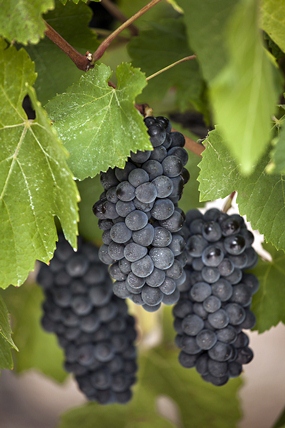How can you describe red wine without mentioning tannins? Not very easily, I have to admit, because tannins appear in all of them, more or less. In red wine, the tannin comes from the grapes, seeds, skins and stems that are heaved into the crusher, unlike white wine in which only the grape juice is normally used. If the wine is aged in wooden barrels, a secondary source of tannin comes from the wood.
So what does tannin taste like? If you have the time and the inclination, make a very strong cup of tea without milk and let it go cold. Then taste it. That dry, mouth-puckering sensation on the inside of your cheeks is the tannin.
 Merlot grapes on the vine.
Merlot grapes on the vine.
Tannins are important to red wine because they provide color, flavor and structure. They also act as a preservative and over time, they tend to soften in flavour.
Paul Mas Merlot 2010 Pays d’Oc (red), France (Bt. 449 @ Villa)
This attractive wine is made from 100% Merlot (mehr-LOH) grapes from the valleys of the Languedoc and is produced by Domaines Paul Mas, one of the largest and most successful wine companies in the region. It’s a deep purple colour with hints of ruby. You’ll probably notice the warm, rounded aroma of plums and black berries with overtones of mint and cocoa.
Dry and medium-bodied, the wine has an exceptionally soft and silky mouth-feel. There’s plenty of sweet black fruit on the palate and a gentle caress of ripe, firm tannins. I know the expression “gentle caress” sounds a bit precious, but I can’t think of any other way of describing it. You might notice hints of licorice too. It has a long, dry and peppery finish and although the wine is a Merlot in character, I think the wine-makers have brought out its more feminine side.
At 14% alcohol content, this would make a good partner for most red meat dishes, lamb or veal. Probably roast turkey too, if you want a red wine for the Festive Season. But you know, I’d be quite happy to enjoy this on its own. It’s a very satisfying, homely sort of wine that I’d like to drink sitting in a comfortable old chair, a good book to read and a large brown dog on the floor. You should try it, especially if you prefer reds with soft tannins. And if you don’t happen to have a large brown dog, I know a good place where you can rent one.
Château Alvina 2010, (red) Cahors, France (Bt. 449 @ Villa)
If you prefer your reds with a bit more bite (because the tannins are more pronounced), take a look at this. It comes from Cahors (kah-OR); some way further north of the Languedoc and almost on the same latitude as Bordeaux. In Cahors, wine regulations require that 70% of all red wines comes from Malbec grapes, known locally as Auxerrois. The remaining 30% of the blend (and I’m guessing here) is probably Merlot and a local grape called the Tannat. Cahors is traditionally known for its dark, inky and tannic wines, so dark that in the past they were known as “the black wines of Cahors”. They were popular with the English as long ago as the 13th century and King Henry III (1207-1272) evidently enjoyed them. If the mention of medieval kings makes your mind go blank, he was the child-king who was enthroned at the tender age of nine.
As you might expect, this is a very dense red colour with hints of purple. There’s a delicate but complex aroma of black berry fruit, along with dried herbs, damsons and hints of rustic earthiness. You might also detect cherry, menthol and a reminder of fresh moist tobacco on the smell. The wine is medium-bodied, a good bit of fruit on the palate and – thanks to the Malbec in the blend – a very pleasing tannic grip that gives it a firm body. There’s also a slight tang of acidity and an attractive dry, tannic finish. At nearly 14% alcohol content, it’s a satisfying and well-balanced wine which would enhance most meat dishes, cheese and pasta.
A Dutch website, describing this wine says, “Lange, kruidige, aardse afdronk die goed in balans is”. This I presume means “If drink it for too long, you’ll get half-drunk, and unless your balance is good, you’ll land on your bum”.




